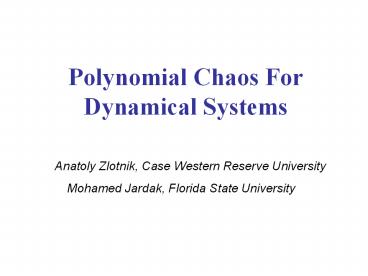Polynomial Chaos For Dynamical Systems - PowerPoint PPT Presentation
Title:
Polynomial Chaos For Dynamical Systems
Description:
... necessary data now allows for direct calculation for systems with higher order ... Calculation of Polynomial Chaos Coefficients by Fast Unified Algorithms ... – PowerPoint PPT presentation
Number of Views:263
Avg rating:3.0/5.0
Title: Polynomial Chaos For Dynamical Systems
1
Polynomial Chaos For Dynamical Systems
- Anatoly Zlotnik, Case Western Reserve University
- Mohamed Jardak, Florida State University
2
Abstract
- The goal of this project is to implement a
polynomial chaos representation to characterize
the behavior of random dynamical systems.
Polynomial chaos, or PC, can provide information
about the probability density of the solution to
a system of ordinary differential equations with
random components as an alternative to costly
Monte Carlo methods. The project includes
examination of numerical aspects of PC
implementation. A fast unified algorithm has
been developed for calculating the necessary
coefficients using an analytic technique. Rapid
computation of the necessary data now allows for
direct calculation for systems with higher order
nonlinear terms, leading to a re-evaluation of
accuracy in pseudo-spectral, or PS,
approximations. This will also lead to higher
numerical stability for applications to highly
nonlinear systems.
3
Stochastic Differential Equations and Spectral
Collocation Method
4
Stochastic Differential Equations and Spectral
Collocation Method (cont.)
5
Applications To Dynamical Systems
Solutions are obtained using an 8th degree PC
expansion and the ode45 routine in MATLAB with
relative integration tolerance at 1e-6. P1 ODEs
are solved, giving a stochastic series expansion
at all grid points. The series is used at each
point to simulate a data set by Monte Carlo, and
to estimate a PDF. Color plots are used to
illustrate the variation of the solution PDF with
time. Blue and red indicate low and high
probability density, respectively.
6
Applications To Dynamical Systems (cont.)
7
Applications To Dynamical Systems (cont.)
8
Applications To Dynamical Systems (cont.)
Lorenz System
Initial conditions in x, y, and z are normal
random with mean0.01 and std0.001. The
coefficients sigma, rho, and beta are the
standard 10, 28, and 8/3, respectively. The
spatial variables are expanded in PC. As the
system moves around the first attractor, the
solution PDF has a small range and high
probability density. At T23, The position of
the oscillator becomes highly uncertain. The PDF
has a much broader range, and lower density. The
profiles of the PDF at various times also display
this behavior. The solution undergoes a sort of
bifurcation at certain times, where it is
likely to be near one attractor or the other, but
less likely to be in the middle. In this
situation, the PDF has two peaks, and the mean
and variance alone mean little.
9
Applications To Dynamical Systems (cont.)
10
Calculation of Polynomial Chaos Coefficients by
Fast Unified Algorithms
11
Tools For Analysis of Dynamical Systems
Bifurcation Map of 4th order Runge Kutta ODE
solver and a Basin Attractor Map for the Damped
Forced Pendulum ODE via Interpolated Cell Mapping
12
In the case of Van Der Pols equation,
pseudo-spectral routines performed poorly in
calculating the 3rd order nonlinear term compared
to the full-spectrum method. 8th degree PC was
used solve in both variations. The plot at left
shows that there is significant error in
pseudo-spectral calculation with error in the
0th, 3rd, and 8th solution given. The plot at
right shows that pseudo-spectral methods work
poorly when all chaos coefficients are of similar
magnitude. Even if magnitude decreases
exponentially with chaos order, errors still
appear.
13
(No Transcript)
14
Conclusions
- Polynomial Chaos is a promising tool for analysis
of stochastic processes. More research into the
stability of the Stochastic Collocation Method
and related numerical aspects is necessary. A
number of numerical and analytical challenges
remain to be overcome before reliable application
to complex dynamical systems.
15
References
- Xiu, D and Karniadakis, G. The Wiener-Askey
Polynomial Chaos for Stochastic Differential
Equations, SIAM, 2002 - Debusschere et. al, Numerical Challenges in the
Use of Polynomial Chaos Representations for
Stochastic Processes, AMS, 2001 - Heath, M.T. Scientific Computing, McGraw Hill,
New York 2002 - Abramowitz, M. and Stegun, I. A. (Eds.).
"Orthogonal Polynomials." Ch. 22, Handbook of
Mathematical Functions. New York Dover, pp.
771-802, 1972.































